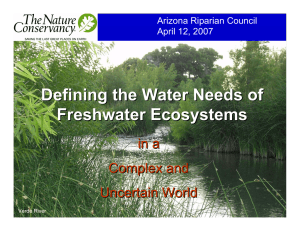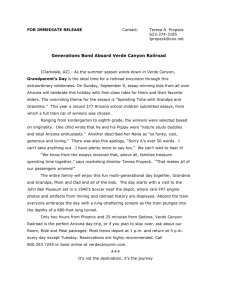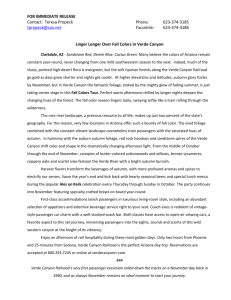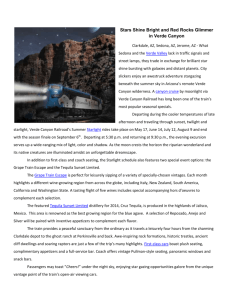Document 11863882
advertisement
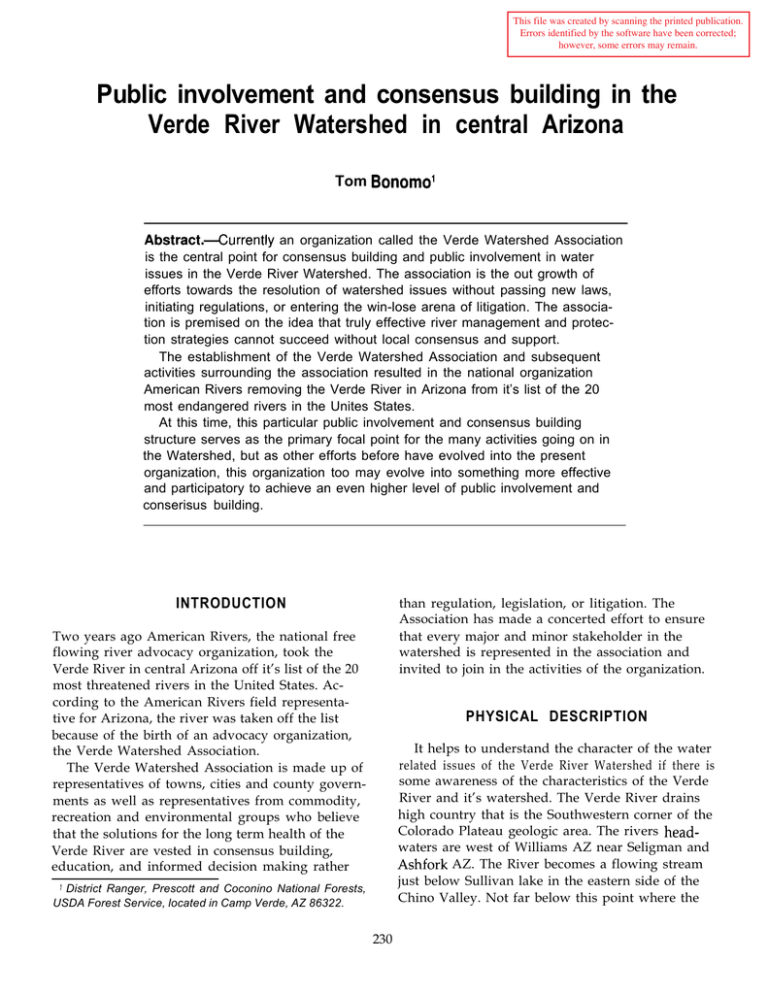
This file was created by scanning the printed publication. Errors identified by the software have been corrected; however, some errors may remain. Public involvement and consensus building in the Verde River Watershed in central Arizona Tom Bonomol Abstract.Xurrently an organization called the Verde Watershed Association is the central point for consensus building and public involvement in water issues in the Verde River Watershed. The association is the out growth of efforts towards the resolution of watershed issues without passing new laws, initiating regulations, or entering the win-lose arena of litigation. The association is premised on the idea that truly effective river management and protection strategies cannot succeed without local consensus and support. The establishment of the Verde Watershed Association and subsequent activities surrounding the association resulted in the national organization American Rivers removing the Verde River in Arizona from it’s list of the 20 most endangered rivers in the Unites States. At this time, this particular public involvement and consensus building structure serves as the primary focal point for the many activities going on in the Watershed, but as other efforts before have evolved into the present organization, this organization too may evolve into something more effective and participatory to achieve an even higher level of public involvement and conserisus building. than regulation, legislation, or litigation. The Association has made a concerted effort to ensure that every major and minor stakeholder in the watershed is represented in the association and invited to join in the activities of the organization. INTRODUCTION Two years ago American Rivers, the national free flowing river advocacy organization, took the Verde River in central Arizona off it’s list of the 20 most threatened rivers in the United States. According to the American Rivers field representative for Arizona, the river was taken off the list because of the birth of an advocacy organization, the Verde Watershed Association. The Verde Watershed Association is made up of representatives of towns, cities and county governments as well as representatives from commodity, recreation and environmental groups who believe that the solutions for the long term health of the Verde River are vested in consensus building, education, and informed decision making rather PHYSICAL DESCRIPTION It helps to understand the character of the water related issues of the Verde River Watershed if there is some awareness of the characteristics of the Verde River and it’s watershed. The Verde River drains high country that is the Southwestern corner of the Colorado Plateau geologic area. The rivers headwaters are west of Williams AZ near Seligman and Ashfork AZ. The River becomes a flowing stream just below Sullivan lake in the eastern side of the Chino Valley. Not far below this point where the ’ District Ranger, Prescott and Coconino National Forests, USDA Forest Service, located in Camp Verde, AZ 86322. 230 river first flows to the surface it is joined by Granite Creek which is the outlet for the Prescott Basin. The river flows east for about 20 miles before it meets the next major drainage, Sycamore Canyon. Sycamore Canyon drains the Coconino Plateau country between Williams and Flagstaff Arizona. Upon joining with Sycamore Canyon, the Verde River turns south-southeast and flows through the Verde Valley in central Arizona. Within the Verde Valley, the river is joined by three other major drainages that come off of the southwest corner of the Coconino Plateau. These drainages are Oak Creek, Beaver Creek, and West Clear Creek. The southwestern corner of the Coconino Plateau begins what is called the Mogollon Rim along the east side of the Verde Valley and continuing east into New Mexico. As the river leaves the Verde Valley it enters a narrowed area between the Mogollon Rim and the Black hills/Verde Rim along the east side of the Verde Valley. It is in this area that the Verde becomes the congressionally designated Verde Wild and Scenic River. As the river flows south, through the Verde Wild and Scenic River Area and the Matzatzal Wilderness in central Arizona, it is joined by two other major tributaries, Fossil Creek, whose waters provide water to the Childs and Irving hydroelectric power plants, and the East Verde River, which drains the Rim country between Payson, Arizona and the very distinct Mogollon Rim north of Payson. The river flows south toward the Salt River Valley where it encounters Horseshoe Dam and Reservoir, the first of two major irrigation storage and flood control dams along the river. By this time the river has left the Matzatzal Wilderness and the Verde Wild and Scenic River Area about 10 miles behind. From Horseshoe Reservoir to Bartlett Dam and Reservoir on the river is about 7 miles. From Bartlett Dam and Reservoir, the river flows south for 15 miles through the Salt River Valley where it joins the Salt River a few miles east of Phoenix Arizona. The Verde River watershed is about 6,600 square miles (4.4 Million acres) in total area. Sixty eight percent of the lands of the watershed are National Forest lands. The remainder of the lands within the watershed are primarily private and State land with small amounts of National Park Service and Native American reservation lands. The Verde River was designated as a Wild and Scenic River in 1984 as a component of the Arizona Wilderness Bill for National Forest Lands. At this time it is the only designated Wild and Scenic River in Arizona. This river and it’s tributaries and the associated riparian areas are habitat for 18 threatened or endangered species. The Verde River is one of the best examples left in Arizona of a large free flowing river in an desert environment. WATERSHED ISSUES The major threat to the Verde River is the potential for increasing groundwater pumping in the watershed to eventually dry up part or all of the,river for parts of the year. The population within the watershed was 102,740 in the 1990 census, predicted to be 125,141 by the year 2000 and 234,400 by the year 2040 by Arizona Department of Water Resources in their statewide water planning documents’. There are 1Arizona Department of Water Resources, Statemde Water Planning, 1994. Figure 2. Verde Cooperative River Basin Study. 231 an estimated 120,000 people in the Verde River Watershed at this time. A majority of these people live in either the Prescott area or in the Verde Valley. The population in the watershed grew by 58% in the 10 years between 1980 and 1990 and the growth is accelerating in the 1990’s. The real estate industry and construction industry in the Verde River Watershed is booming. One town in the watershed, Prescott Valley, grew over 30 percent during an 18 month period in 1993 and 1994. It has now slowed to a rate of growth of about 15 percent a year*. The flow in the Verde River for a majority of the year is from groundwater coming to the surface in springs or aquifers that feed the river. The flows at the lower end of the Verde Valley where the river becomes a designated Wild and Scenic River are between 50 and 200 cubic feet per second for 9 to 11 months each year. During periods of winter snow melt the river will flow to between 1000 and 6000 cfs for a period of 2 weeks to 2 months and during the summer rainy periods, the river will swell to the 300 to 500 cfs level for a week at a time. Groundwater is the lifeblood of the Verde River. In addition to the communities and population within the watershed using groundwater there is valid reason to believe that communities located just outside of the watershed area may be using ground water that would become surface water flowing in the Verde River. The well fields that Flagstaff AZ uses to provide a significant amount of water to it’s almost 70 thousand residents, are suspected to be tapping geologic formations that also provide spring water to Oak Creek, a major tributary to the Verde River3. The well fields used by Payson AZ are also suspected to be tapping aquifers that feed the Verde River System*. Over the last 20 years there have been numerous actions and events which have enhanced public involvement and awareness in Verde River and Verde Watershed issues. In the late 1970’s Maricopa Audubon Society filed a lawsuit which forced the Forest Service to develop strategies and actions to protect Southern Bald Eagle and it’s habitat. The Southern Bald Eagle had just recently been added to the Threatened and Endangered Species list. Most of the mitigation strategies centered around the enhancement of riparian habitat along the rivers and streams by improved livestock grazing practices. One of then Governor Bruce Babbitt’s last actions before he left office in the mid 1980’s was to allocate money to Arizona State Parks for purchase of riparian lands for a Greenway along the river in the Verde Valley. Lands in the floodplain of the Verde River were purchased adjacent to Deadhorse Ranch State Park and have become the Verde River Greenway, a component of the Arizona State Park System. These land purchases were controversial in the beginning but the Greenway is now well supported by the public as they become more aware of the values of these lands. In 1984 a 39 mile stretch of the Verde River below the Verde Valley was designated as Verde Wild and Scenic River as a component of the Arizona Wilderness Bill. Early public involvement in the Wild and Scenic River suitability study was heavy with public opposition to designation., When the designation of one segment of the river was included as a part of the Arizona Wilderness Bill 10 years later, opposition was light. During the mid 1980’s gravel mining in the Verde River floodplain was a common occurrence in the Verde valley. In 1986, concerns about the impacts of the alteration of the river channel caused by gravel mining in an area adjacent to the Verde River Greenway sparked action by State Attorney General. The Arizona Attorney General’s office contended that under the equal footing doctrine, Arizona had never made it’s rightful claim to the navigable waterways of the State and that the lands the gravel companies were mining were in fact state lands. The Equal Footing Doctrine is a policy supported in law whereby all states in these Unites States become states with the same rights and privileges that any other states had as they entered the Union. This action sparked the Arizona State Legislature to pass a law that gave private landowners along the rivers of the state an opportunity to acquire a Quiet-Claim Deed to the floodplain lands adjacent to their property by paying a $25 per acre 2 Conversation with Ken Rittmer, Town Manager, Town of Prescott Valley, AZ, 1995. 3 Conversation with Ed McGavock, Sedona AZ, retired administrator, US Geological Survey, 1994. 4 Conversation with Dennis Sundie, Water Resources Planner, Arizona Department of Water Resources 1994. 232 and other issues of the Verde River Basin. Some of these are rather formal and mandated by law such as the Prescott Active Management Area Groundwater Users Advisory Council, and some of these groups and organizations were more loosely associated like the Verde River Association, a group of agency staff, private citizens, Natural Resource Conservation Districts, Resource Conservation and Development Area representatives, and elected officials meeting periodically to discuss the Verde River issues in the Verde Valley. One of these groups, the members of the Verde River Corridor project, met for over a year to discuss the issues along the Verde River in the Verde Valley. The Verde River Corridor Project was a locally directed effort with staff support from Arizona State Parks. There was representation on the steering group of all major and minor stakeholders along the river. The goal of the project was to examine all uses and values of the river corridor, agree on a common vision, and develop a plan of action that could be supported by the public. The strength of process used in the Verde River Corridor Project was the acknowledgment of two simple yet essential ideas about river management. No public action can replace wise use of a river by those living along it. Effective river management cannot succeed without local consensus and supports. The Verde River Corridor Project was year long process that resulted in heightened awareness of the issues facing the river and pointed out the need for further actions. The process pointed out a need to address the water issues of the Verde Valley in a broader context by looking at the whole river basin, acknowledging the interconnection between all the water issues and addressing the total spectrum of these water issues. To effectively address these issues, a member of the Yavapai County Board of Supervisors from the Verde Valley proposed that COCOPAI Resource Conservation and Development Area hold a conference to bring interested and affected groups and individuals in the watershed together. COCOPAI would facilitate discussion of water related issues in the basin and what the group fee. This law has since been overturned by the Arizona Supreme Court and a second law was passed which charged the Arizona State Land Department to determine what watercourses were navigable at statehood and present these as the lands that should have become state lands upon statehood. Arizona State Land Department is still in the process of developing criteria to determine just what streamcourses were “navigable” at the time of statehood and thereby, which rivers and floodplains might actually be owned by the state under the Equal Footing Doctrine. In the mid 1980’s Threatened and Endangered Species habitat for a small fish called the Spikedace (Meda Fulgida) stopped proposals for removing water from the river to fill headwaters Central Arizona Project allocations. As part of the Central Arizona Project, 7 different entities in the Verde River Basin were given allocations for CAP water. It was assumed all along, that these communities, Cities and Tribes would take water that belonged to downstream water users in exchange for water flowing in the Verde River system. The downstream water users would trade this Verde water for CAP water from the Colorado River which would come to the Salt River Valley via the CAP canal. The first city to actively pursue this option sought to place a withdrawal system in the upper Verde River to pump water to their city storage facilities. This proposal was dropped when it was determined that this withdrawal of water from the upper Verde River would have a negative impact on the habitat for the Spikedace. PUBLIC INVOLVEMENT In the late 1980’s various individuals began a concerted process to develop public awareness and appreciation for the river and it’s values. State and county elected officials and various agency heads became more aware of the Verde River’s values after spending time floating on the river and appreciating the wildlife and lush vegetation along it. An annual event called Verde River Day was started in the Verde Valley as an appreciation day for the river. This event has been a huge success. Many groups and organizations have formed over the last 10 years to discuss the water issues 5 Verde River Corridor Project Overview, Tanna Thornburg, Arizona State Parks, 1993. 233 could do to begin understanding and addressing these issues. COCOPAI sponsored the first Verde River Watershed Conference on April 20-22,1992. On the first day of this conference 160 participants heard from about 15 speakers giving advice and information about the many and varied issues that relate to water in the Verde River basin. The speakers urged communication, and seeking consensus in the resolution of the issues rather than litigation, regulation or legislation. The Conference participants agreed that solutions to issues in the Verde River Watershed would be better supported if generated by stakeholders through consensus building and they worked in small groups to develop ideas about a strategy or organization that could be used to facilitate this communication and consensus building. The participants had many good ideas and agreed that a group of volunteers called a “bridging committee” should take the ideas and develop them into an organization that would best function to develop consensus and facilitate communication among the varied interests in the basin. The bridging committee met numerous times over the next 8 months and came to the consensus that an organi- Figure 3. Verde Cooperative River Basin Study. Coconino, Gila, Maricopa, Mohave, Yavapai Counties, Arizona. zation called the Verde Watershed Association should be formed. A proposed organizational structure was developed as well as proposed bylaws and organizational objectives. On January 16,1993, the second Verde River Watershed Conference was held to formally organize the Verde Watershed Association. The Association meets monthly at different locations in the Verde River watershed to educate and communicate about the issues, projects and new items of interest related to the watershed. The association also holds special meetings and seminars to address current issues and educate public about these issues. State and Federal agencies are invited to participate and asked to provide assistance to the activities of the association, but are not members. This was a conscious decision by Association organizers to ensure that the local entities and individuals remain in the leadership roles within the Association and the activities and processes of the Association never become another state or federal problem solving activity with the baggage of, “we’re from the government and we’re here to help you”. Figure 2. Verde Cooperative River Basin Study. 234 With the assistance of the Arizona Department of Water Resources, the VWA adopted a three phase plan for the development of a management strategy for the water resources of the watershed. Phase 1 is the gathering and compiling of existing information about water resources in watershed. Phase 2 will be to do further studies to fill in information gaps necessary to develop a management plan. Phase 3 will be the development of a water resources management strategy for the watershed with broad based public support. VWA is currently applying most of it’s effort in Phase 1, the information gathering and compiling phase although there are some efforts going on which fall into Phase 2 which will fill generally recognized information gaps by doing specific studies. The Natural Resource Conservation Service (formally SCS) is currently conducting the Verde Cooperative River Basin Study in the Verde River watershed. This study is sponsored by the six Natural Resource Conservation Districts in the watershed with participation by all the agencies, both federal and state, that have an interest in the water issues in the watershed. The goals of the Verde Cooperative River Basin Study are: l Provide for continuous and widespread public involvement throughout the study period and beyond. l l usable between agencies and by planners, decision makers, and the public. A spinoff benefit of initiating Phase 1 of the Water Management Strategy for the Verde River Watershed has resulted in additional attention being given to the water resources of the watershed by state and federal agencies. Arizona Department of Environmental Quality has established the Verde Management Zone for water quality planning. The Verde Watershed Watch Network has been formed. This network is six watershed area schools nvolved in water sampling and testing as well as other activities related to water quality and riparian areas. The project is funded by grant monies from the Environmental Protection Agency and the project is administered by Arizona Department of Environmental Quality and Northern Arizona University. The US Geological Survey is including the Verde River Watershed in one of the 60 National Water Quality Assessment Program projects in the nation. The Central Arizona Study Unit includes the Salt, San Pedro, Santa Cruz, Verde and a part of the Gila River. The Verde is included in the study because of the relatively pristine nature of the water and the strong biological component of the study. The National Water Quality Assessment Program is a long term program designed to study trends in the quality of a large percentage of the water used nationwide over a long period of time over different types of watershed areas by sampling for nutrients, pesticides, trace metals, and industrial organics. The Environmental Protection Agency and the Army Corps of Engineers have determined which stretches of the Verde River are “potentially suitable” or “generally unsuitable” for the future discharge of dredged or fill material as part of the EPA Advanced Identification (ADID) process. This study identified the values inherent in the various reaches of the river and determined the probability for issuance of “404 permits” for dredge and fill activities in the reaches. The Arizona Department of Water Resources has recently completed a project in the Verde Watershed investigating weather modification potentials. A significant component of the project was the development and testing of computer modeling of winter weather patterns moving across the central part of the watershed. It is hoped Collect existing resource information from various sources (local, state, federal) and put it in a common, publicly available database. Determine what additional information is needed to allow for an accurate understanding of the basin’s resources and associated issues6 A comprehensive database compiled on a GIS (Geographic Information System) format will be used to allow local people to begin to plan for sustainable uses of the available water resources in the basin. The Verde Watershed Association has adopted a policy of encouraging all agencies doing studies to document in GIS format so data is more 6 Plan of Work, Verde Cooperative River Basin Study, Dino Desimone, Natural Resource Conservation Service, Arizona State Office, 1995. 235 District. The Natural Resource Conservation Districts have provided a convenient legal mechanism for grassroots participants to enter into partnerships with federal and state agencies to do needed work. These partnerships can happen because of the many legal abilities that Natural Resource Conservation Districts have as subdivisions of the state. The Verde Watershed Association partnership-with the Verde NRCD has proved to be a valuable asset in accomplishing work that otherwise could not be done. It is unknown whether the Verde Watershed Association will grow into the 21st century as the appropriate structure to assist in the preservation of the Verde River as a flowing stream, but to date it has served it’s purpose well and is currently the major catalyst for public awareness and information about the threats to the river. that this modeling will give better winter storm moisture prediction accuracy and better and earlier warning when storms with a potential for flooding are moving toward the watershed. The Verde Watershed Association has been playing a role in these studies as a coordination point and by providing advisors to these studies. Verde Watershed Association currently has a worldwide web site on the Internet and has a vision that this Internet connection will enable access by any agency or individual to the all of the existing information relating to the watershed. The Internet E-mail address is: verde@sedona.net and the Internet WWW Page address is: http:// www.verde.org/ . The Internet activity of the Association as well as the publication of the Association newsletter,The Co$uence, is funded by the Bureau of Reclamation through the Verde Natural Resource Conservation 236
